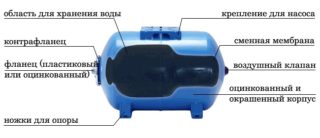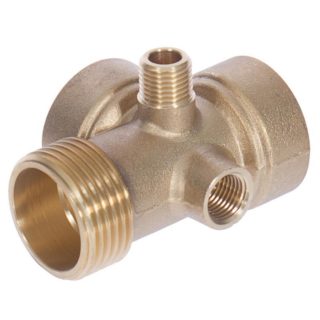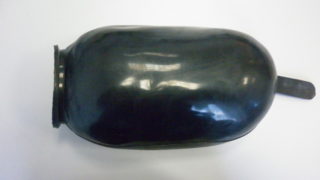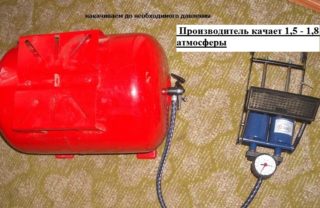A hydraulic accumulator is necessary to maintain constant pressure in the water supply network, as well as to provide protection against water hammer. If the device is out of order, most of the damage can be corrected by hand. To do this, you need to choose the right replacement parts.
Basic spare parts for accumulators

The hydraulic accumulator is a stainless steel or plastic tank with a rubber membrane inside. It is attached to the bottom of the case with a flange and divides it into two compartments. If the accumulator is larger than 100 liters, additional fixing at the top is usually required. For this, a special holder is used - a nipple with a threaded connection.
A fitting with a nipple for air injection is installed at the end of the accumulator. In the process of pumping water into the accumulator, the diaphragm expands, and as a result, it compresses the air that is between it and the walls of the tank. This design contributes to the fact that the liquid is under constant pressure, as a result of which the number of inclusions of the pressure plant decreases and its service life increases.
Other parts required for the proper functioning of the hydraulic tank:
- A flexible hose is needed to connect the storage tank to the pumping unit.
- The non-return valve is installed on the suction pipe, which is lowered into the well or well, so that the liquid does not flow back into the source during pumping.
- The spool is used to inject air into the device. It also checks the pressure in the air chamber.
- Control devices allow you to maintain a constant pressure in the water supply system. The control unit includes a pressure switch and a pressure gauge. The first device is responsible for starting and stopping the engine, and the second monitors the water pressure in the system.

For the convenience of connection, many hydraulic tanks now use a special part - a five-piece or a five-outlet fitting for a hydraulic accumulator. This is a special unit that allows you to connect everything you need for autonomous water supply.
The five-outlet element is called so because it can be used to put together five different components: a pumping device, a hydraulic tank hose, a pressure gauge, a pressure switch and a dry run. If an element is not required to be connected, plugs are used. Prices for a brass five-piece for a hydraulic accumulator are in the range of 300-400 rubles.
During installation, the device stands on a special stand. But it is quite possible to hang a small device on the wall using a strong clamp.
Most components can be replaced when worn. But sometimes the hydraulic accumulator is non-separable, which makes it impossible to change the membrane. If it malfunctions, the entire drive is subject to replacement. The cost of such devices is less.
Criterias of choice
Most often, problems in the operation of the hydraulic tank are associated with the wear of the diaphragm part and the flexible hose for connecting the accumulator to the pump.
Before buying a new diaphragm, you need to make sure that the volume of the diaphragm is suitable for the drive. A membrane with a volume smaller than the calculated one will fail much faster. When choosing a diaphragm, you also need to pay attention to the quality of the rubber. It should be dense, strong, without any signs of cracking. Membranes are budgetary in price - it starts from 200 rubles.
As for the liners, you should purchase polymer and non-crease flexible reinforced products. Their cost starts at 500 rubles. The accumulator hose must be of the same cross-section as the flange.
When choosing a pressure switch, it is required to take into account the peculiarities of a particular water supply system, primarily the characteristics of the hydraulic tank and pressure equipment. The cost of such a device is from 350 rubles.
The mounting flange, made of stainless steel or plastic, is fitted with a ½ or ¾ in. Male thread for water connection. It is imperative to check this value when purchasing a part, as it varies from manufacturer to manufacturer. Such a spare part costs from 240 rubles.
Replacing parts

If a breakdown occurs, requiring replacement of hydraulic tank components, you need to call a specialist or take the drive for repair to a service center. Nevertheless, if you wish, you can repair the accumulator yourself.
According to the reviews of the owners of the tanks who carried out their own repairs, the easiest way is to replace the hose, pressure gauge and pressure switch through the five-piece, and from the internal elements - the membrane. Before replacing a defective diaphragm of the hydraulic accumulator, it must be depressurized. To do this, disconnect from the mains, shut off the fluid supply, drain the residues.
When replacing the rubber "bulb", the procedure will be as follows:
- Loosen the flange mounting bolts and remove them.
- Remove the failed element through a special hole in the bottom of the battery.
- Inspect the membrane and assess the extent of the damage - is it possible to repair it.
- Clean the inside of the drive from rust and deposits, and the flange from possible burrs.
- Take the holder and insert it into the hole located on top of the "pear".
- Place the membrane in the hydraulic tank, and, screwing the bolt into the holder, insert it into the opening located in the bottom of the body.
- Spread out the throat and fix it with a flange, tightening the bolts from opposite sides.
After assembling the device, in the reverse order, you need to pump air into the accumulator. This will allow the drive to function normally. The injection is carried out by means of a conventional pump through a spool located on the outside of the housing.
If the connecting flange has deteriorated, which sometimes happens due to the quality of the water, it will not be difficult to replace it either. The procedure is similar to replacing a worn out diaphragm, but you do not need to remove the bulb and clean the inside of the drive. Make sure that the leaks are caused by the flange itself, and not the wear of the seal to it. Perhaps it is enough to replace the rubber gasket, which costs a penny.
Operating rules
- in systems with liquids that differ in properties from pure water;
- in networks with a pressure greater than the maximum allowable;
- in pipelines with a liquid temperature exceeding the standard values.
It is strictly forbidden to increase the working pressure indicators above the maximum permissible values in the air and water compartments of the accumulator, both during operation and when presetting the pressure.
During the operation of the device, malfunctions may appear. For example, frequent starts and stops of pumping equipment. The reason is low pressure in the air chamber of the hydraulic tank or a ruptured diaphragm.
To check the integrity of the diaphragm, press the spool using a match or a thin screwdriver. The release of air together with water indicates a rupture of the pear. If there is no water, you just need to pump air. In the absence of an air cushion, the diaphragm is in contact with the walls of the body, which leads to its damage - it is wiped off. This is perhaps one of the most common hydraulic tank malfunctions.
If there is a tendency for a constant decrease in pressure, you need to check the accumulator for leaks. A soap solution should be applied to the joints. Next, you need to tighten the bolts on the flange or the nut on the nipple.
Also, during the operation of the hydraulic tank, in order to increase its service life, it is necessary to monthly check the pressure of starting and stopping the pumping equipment for compliance with the established indicators that were set during setup.
Every six months you need to check:
- the device itself for external damage, rust, dents and leaks;
- pressure in the air chamber, for compliance with the established indicator by means of a car pressure gauge;
- the integrity of the pear.
For long-term storage, the hydraulic accumulator must be drained and placed in a dry place. If the operational period has exceeded three years, comprehensive prevention should be performed. For this, the device is disconnected from the water supply network and the membrane is replaced. It may also be necessary to change the flange and nipple.
You can easily repair the battery yourself. If it is necessary to change spare parts, it is better to purchase original parts, since each manufacturer sets its own sizes of components.









